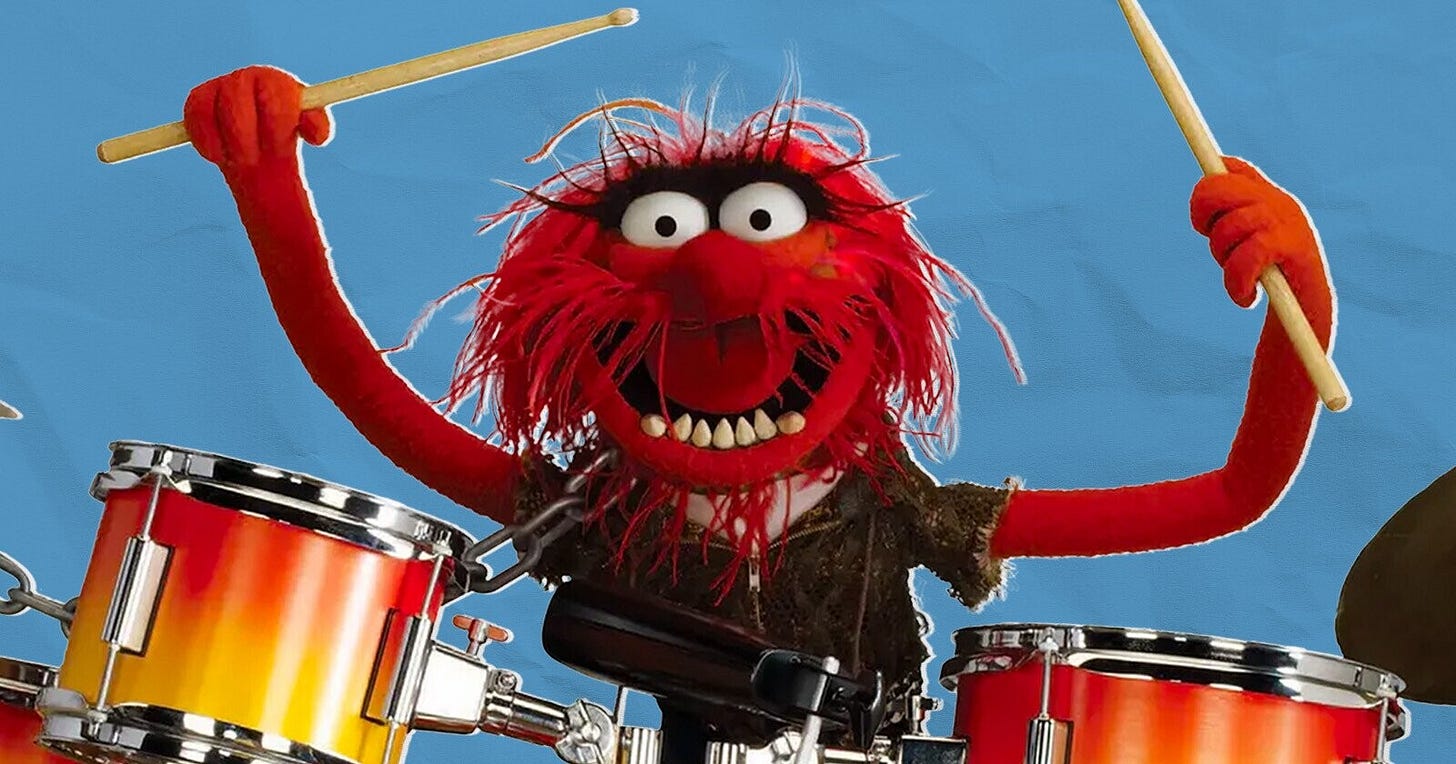This is Culture & Code, a weekly newsletter and podcast about Creativity and Artificial Intelligence. Culture & Code explores innovation across storytelling, technology and audiences to help creative professionals collaborate better with AI and each other.
Generative AI as a Drum Machine Part III
https://www.cracked.com/article_37948_three-famous-drummers-on-how-well-animal-from-the-muppets-swings-the-sticks.html
Circa 2025, the popular wisdom states, “Generative AI is just another creative tool”. The comparison makes sense. It keeps humans in the loop. It’s not threatening.
I also believe it’s wrong because it’s incomplete.
After the Lumiere Brothers developed photographic technology to capture moving images, the creative agenda was NOT to become better and better at recording 19th century stage plays or street scenes. It was to go out and invent movies! It was to create flash cuts, fade outs, jumps and many other types of storytelling craft that transformed moving images into a unique narrative experience we now call film.
Myself and others like Adrienne Lahens are starting to believe a better metaphor for understanding how AI impacts creativity and the audience experience is to conceive of Gen AI more like a drum machine than just a tool.
This article concludes a three part series about AI as a drum machine. Part I offers a brief history of how drum machines like the Roland TR-808 changed how musicians expressed themselves and ignited cultural moments. Part II dug deeper into of fandoms and social scenes driving innovation around drum machines and what that means for Gen AI.
What follows are practical steps I believe will help creators orient around the drum machine concept of Generative AI. It concludes with a call to arms to all the weirdos out there to leverage the new capabilities for better storytelling and better AI.
Step 1. Find Your Weird and Own It
Gen AI often produces results that feel “off”. However, those quirks are your creative leverage. The point isn’t to use Gen AI just to make media faster, better, and cheaper. The target is resonance. It shouldn’t matter to people whether or not the final work was made with AI. It should matter only that the work is good.
Tip: Launch a creative project where the only rule is: “Make it feel like nothing I’ve done before.” The goal of the project is about the feeling. Once you hit a vibe that appeals to *you*, follow it down the rabbit hole as deep as you can.
Step 2. Embrace Shipping as Innovation, not a Chore
Create production flows that let you generate, refine, and publish fast—without sacrificing your intent or taste. The more repeatable your processes, the easier they become. But they’ll never be 100% or even close to that, which is great because the exceptions are the seed corn for a unique style. But you won’t see the exceptions for what they could be unless you’re already dialed into how to ship quality work on a regular basis.
Tip: Start a weekly ritual: Prototype on Monday, develop mid-week, release Friday. Recharge on the weekends. Keep your “dropped” folder growing. Then you can benchmark your development.
Step 3. Start with a Micro-Scene
Most influential creative movements start as subcultures—block parties, basement shows, online forums. A “scene” doesn’t automatically mean something has gone viral. A scene results from cultivating a space where people care enough to return and eventually contribute.
Tip: Brand your world and build for intimacy before scale. Set regular drops or events where your audience can gather and go deeper. Better to gain intimate fans first who’ll shout about what they want than get a pile of undifferentiated likes and shares.
Step 4. Collaborate like a Session Player More than a Star
AI makes it easy to jam with others—across time zones, genres, and disciplines. Embrace being a sampler and builder of creative networks. Scenes don’t grow in isolation. They grow from interplay. Meet people and learn about their jams, their desires. Doesn’t mean you must ape their style or tune your work just to perform on social networks (although that’s not all bad).
Tip: Organize open development get togethers to make short form AI stories so people learn how to collaborate better with AI and each other. Assign roles: sound, visuals, writing, animation. Use a shared folder and short cycles.
Step 5. Put Creative Feelings in Motion
Drum machines didn’t spark music scenes because they sounded like human drummers. They sparked scenes because the music and the settings inspired people to move. Similar forces at work with AI storytelling. Your goal isn’t realism—it’s feeling. If your audience laughs, gasps, feels seen, or shares your work with someone, you’re on the right track. Once creative energy is in motion, keep pushing it forward. Energy before understanding.
Tip: Ask this after each project: “What feeling did this spark?” Try to get the audience to articulate it. Survey it. Track this question more than how many views or likes.
Step 6. Charge a Premium for the Human Touch
Studios, agencies, and brands want to believe that Gen AI makes good creative 10x faster for 10x cheaper. You must drive a stake through the heart of this myth.
Sure, AI makes parts of production faster—storyboarding, asset creation, first drafts etc. But AI can’t tell a story about being human because it’s not. The heavy creative lift comes from understanding people, crafting narrative arcs, shaping emotional tones. That will always take time, talent, taste and resources. So while staying within general boundaries of a project, you should price your value around the outcomes, not the inputs or processes.
Tip: Break your pricing into two clear parts: (1) Machine-Aided Production (fast, efficient, iterative) and (2) Human-Centered Creative Direction (taste, narrative, audience feel). Make it obvious that the second part is the difference-maker.
Also—be firm. If someone just wants to lop zeros off last year’s rates with a 24-hour turnaround, point them to a template. You’re not a vending machine.
Step 7. Build an Experience that Only You Can Make
AI slop is everywhere. But there’s one thing no human or AI can fake: being human when it matters. That can be in the tough times or the great times. Both are legit. Connection is coin of the realm. Invite your fans early on into your workflows. Give them roles. Make them feel seen.
Tip: Launch a “core scene” membership—limited access. Share your workflows. Give your audiences early previews, collab invites, direct communication. Start it small. Keep it real. Iterate your way to sustainability and profitability.
Bonus: People will pay to belong to something that shines a light on them but ultimately is bigger than them. If your creative work offers that experience, they’ll show up and support it.
Ultimately, Gen AI Must Help the Weirdos Turn Pro
A few years back, two of my sisters telephoned me from the Jekyll Island Shrimp and Grits Festival. The festival happens each October as tourism winds down on the Georgia coast. It’s small but very local, which makes it a great last party of the season.
When they telephoned me, both sisters were feeling no pain, and had connected serendipitously with another family that morning. In fact, they called me from that family’s reunion.
“We’re at the Weirdo family reunion!!”, one sister bellowed into the phone.
“What? Reunion? Nobody told me about a reunion!”, I replied.
“NO!! That’s the name of the family! WEIRDO!!! We’re partying with the WEIRDOS!!”
“So…you’re at a family reunion [PAUSE] but we’re not related?”
“Right! It’s the Weirdo family reunion!!”
You can imagine how the rest of that phone call went. For the record, Weirdo is a proper family name albeit rare. Rather than running from the obvious, this family owned it — all the way to the official Weirdo reunion shirt.
Not many souls can start the day at a shrimp and grits festival, and end up at someone else’s family reunion. But Katherine and Marianne are seasoned professionals at recognizing serendipity. When that happens, the smart move is to chuck the original plan, and roll with whatever comes next.
Ultimately, I believe perceiving AI as a drum machine primes a creator to recognize serendipity and roll with it. Or as Hunter S. Thompson sagely observed, “when the going gets weird, the weird turn pro.”
It’s why we launched Culture & Code — to help creative weirdos turn pro using Generative AI.
Today, everyone can access powerful AI tools to generate and produce content. But that doesn’t mean the content is any good. Powerful as they are, AI tools can’t access your taste, your feelings, your judgment, or the people who helped make you the person you are now.
THAT IS THE BEDROCK upon which you build something new and exciting with Generative AI. Being open to serendipity and rolling with it enables you to tell stories that matter with the care they deserve. And in these times, the world really needs it.
Party on.
Alvin Wang Graylin Speaks of a Superabundant Future with the C&C Podcast
What if the world we live in isn't truly scarce—but just feels that way?
That’s the big idea behind Abundanism, a new framework introduced by Alvin Wang Graylin in this episode of Culture & Code Podcast. Abundanism describes a shift from survival-driven systems to a future built on shared flourishing, powered by technologies like AI, robotics, clean energy, and biotech. Rather than clinging to scarcity, Alvin believe it’s time we prepare for a world of superabundance — but only if we have the mindset to match the tools.
Alvin has been on the front lines of innovation for 30 years. From leading HTC’s XR division in China to his current roles at Stanford’s Digital Economy Lab and the Virtual World Society. He’s seen how fast technology moves—and how slowly mindsets change.
In this deeply personal and wide-ranging conversation, Alvin lays out why a reimagined worldview is urgently needed. “It would be a real shame,” he says, “to be on the one-yard line of a utopia… and fumble it.”
He challenges the idea that humans are hardwired for hoarding and conflict. “We’re a product of our environment,” he explains, referencing our evolutionary cousins, chimps and bonobos. “The environment shaped how those societies formed. We have that same chance now.”
Instead of defining ourselves by jobs, Abundanism asks us to redefine value through dignity and service. “Most of the productivity of tomorrow will come from machines,” Alvin notes. “But the meaning—art, care, discovery—that’s still up to us.”
For creators and technologists, this episode is both invitation and call to action. Alvin puts it simply: “If you can touch people’s emotions with your stories, your code, your design—then you have the power to help change the future.”
🎧 Listen to the full interview HERE
AI Movie Night July 30 Registration is OPEN!!
On July 30 (W) from 6-9pm, the Seattle AI Film Festival takes over VICE Seattle with special guest John Gaeta, Oscar-winning VFX innovator and founder of ESCAPE.ai.
What to expect at AI Movie Night:
- A curated set of top tier AI short films with commentary for why they matter to creatives and technologists
- A conversation with John Gaeta, best known for his Academy Award winning work on the original Matrix Trilogy and for Star Wars Immersive Entertainment. In 2024, John co-founded ESCAPE.ai, which celebrates and supports pioneer creators pushing the envelope of AI, game engines, and emergent technology in pursuit of art, experiences and storytelling.
- Networking at the center of Storytelling, AI and Innovation
- Launch announcement of the Seattle AI Film Festival 24hr Film Challenge in late October 2025.
Registration capped at 150 people. Don't miss out. Follow the link to Lu.ma registration.
https://lu.ma/7174avrg
venue: https://viceseattle.com








